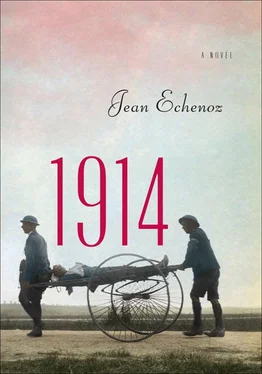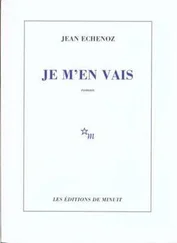ON SUNDAY MORNING, Blanche awoke in her bedroom on the second floor of an imposing residence of the kind belonging to notaries, deputies, public officials, or plant managers: the Borne family runs the Borne-Sèze factory, and Blanche is their only daughter.
A strangely discordant atmosphere reigns in this albeit peaceful and orderly room. Framed local scenes— barges on the Loire, fishermen’s lives on the island of Noirmoutier—adorn the slightly off-center flowered wallpaper, and the furniture bespeaks an effort toward woodlands diversity worthy of an arboretum: a mirrored walnut bonnetière , [5] bonnetière: The bigouden , the elaborate lace bonnet that was the traditional headdress of women in Normandy and Brittany during the seventeenth and eighteenth centuries, is still sometimes worn today on festive occasions. Because of their impressive height, these bonnets were kept in bonnetières , tall, narrow cupboards with a single door, and they can be well over a foot high. A famous Paris Match cartoon by the great Sempé shows a Breton woman sneaking a nip from a wine bottle hidden under the towering lace tube on her head.
a writing desk of oak, a mahogany chest of drawers with fruitwood veneer, while the bed is of wild cherry, the armoire of yellow pine. So, an unusual ambience, and one ponders whether it arises from the mismatched edges—unexpected in what should be a meticulously appointed bourgeois house— of this faded wallpaper in which the bouquets are wilting as well, or from the astonishing variety of furniture woods: one wonders at first how so many different materials can get along together. And then one quickly senses that they do not get along at all, they cannot even stand one another, which probably explains the strange ambience: that must be it.
Until Blanche gets up, this furniture waits patiently to play its role. The night table—of beech—bears a lamp resting atop a few books, including Marc Elder’s The People of the Sea , a volume Blanche dips into occasionally, not so much for its stalwart capture of the previous year’s Goncourt Prize from a field including Marcel Proust as for her family’s friendship with the author, a local man whose real name is Marcel Tendron, and because this work reminds her of past Sunday excursions into the countryside to see the fishermen of Noirmoutier or barges moored for the estuary fishing of eels, lampreys, and elvers at Trentemoult, a village of fishermen and sailors on the left bank of the Loire.
Once out of bed the first thing Blanche did was decide what she would wear, selecting from the bonnetière a light short-sleeved blouse of batiste, from the armoire a suit of gray tweed, then stockings and undergarments from the drawer of the chest, on which a couple of perfume bottles sit forgotten. Hesitating between two pairs of shoes—lower or higher heels?—but not over her hat, a rice-straw affair trimmed with black velvet. After a scant hour in the bathroom, freshly bathed and dressed, she consulted the mirror on the bonnetière with a critical eye, smoothing a lock of hair, adjusting a pleat. As she left her bedroom she passed the writing desk, which had played no part in this morning’s activity; the desk is used to this, serving simply as a repository for the letters Charles and Anthime each regularly sends separately to Blanche and which lie bound by ribbons of contrasting colors in two different drawers.
Ready now, Blanche went quietly downstairs and on her way through the hall to the front door, made a detour to avoid the dining room. There—harsh grating of the bread knife against crust, clinking of teaspoons amid the aroma of chicory—her parents were finishing their breakfast: little audible conversation between Eugène and Maryvonne Borne; rumbling ingestion from the factory owner, melancholy sighs from the factory owner’s wife. Pausing at the front door by the wicker umbrella stand lined with waterproof canvas, Blanche chose a parasol of checked cretonne.
Once outside, she went toward the street entrance to the garden, the main walk of which—white gravel, carefully raked—branches out into lesser paths leading past the shrubberies, pond, arbors, and ornamental trees, including a worn-out palm that has been holding on for too long in this climate. Blanche has also avoided, but with fewer precautions, the hunched figure of the lame gardener—who is as deaf as the palm tree and busy watering the grass borders and flower beds—by simply walking more softly on the crunching gravel until reaching the cast-iron front gates.
Outside, the sounds of Sunday: everything is quieter than on weekdays, the way it is on any Sunday but it’s not just that, not the same silence as usual, it’s as if a residual echo has remained of the clamor and fanfares and ovations of recent days. Early this morning the oldest municipal employees still left in town finished sweeping up the last bedraggled bouquets, rumpled rosettes, tattered banners, and dried-out tear-stained handkerchiefs before hosing down the pavements. A few errant items have been placed in the lost-and-found department: a cane, two torn scarves, and three dented hats, tossed in the air with patriotic fervor and whose legitimate wearers have not yet appeared but are awaited in due course.
The atmosphere is also calmer because there are fewer people in the streets, and fewer young men in particular, or only ones so young that, convinced along with everyone else that this conflict will be brief, they’re ignoring it and don’t let it bother them. The few boys of her age Blanche encounters, who all seem more or less unwell, have been declared unfit for military service, at least temporarily; this might change in the future but they’re not concerned about that either. The nearsighted, for example, currently exempt and protected by their glasses, never dream for an instant that they might be traveling with them one day on a train to the east, with a spare pair of spectacles, if possible. Likewise for the deaf, the flat-footed, those with nervous complaints. As for malingerers or men who, confident of their connections and officially “unfit”, don’t even bother to pretend, they prefer not to show themselves too much for the moment. The brasseries are deserted, their waiters have disappeared: it’s up to the bosses to sweep their terraces and doorsteps themselves. The dimensions of this town drained almost empty of its men thus seem to have expanded: other than women, Blanche sees only old fellows and kids, whose footsteps sound hollow on a stage too large for them.
HADN’T REALLY BEEN THAT bad either, in the train, just uncomfortable. Sitting on the floor they had devoured their provisions, sung every possible song, and booed Kaiser Willy, drinking right along. In the twenty or so stations where the convoy had stopped, they hadn’t been allowed off the train to take a look at the towns but—through windows open to air that was too hot, speckled with sparks, almost solid with a heat coming from who knew where anymore, August or the locomotive and probably both, piling up—at least they’d seen a few airplanes. Some of these, in flight, were crossing a perfectly smooth sky at various altitudes, following or encountering and passing by one another bound on some unimaginable mission; others were sitting around higgledy-piggledy, surrounded by men in leather helmets, on requisitioned fields lying next to the tracks.
The men had heard about them, looked at photos in the newspaper, but no one had yet actually seen any of them, these seemingly fragile airplanes, except Charles no doubt—always au courant with everything, he had even climbed inside or rather onto a few, since there were no cabins yet—but Anthime had looked for him in vain among his fellow passengers. The landscape having about exhausted its attractions, Anthime turned aside to find some other way to kill time: cards, at that point, seemed just the thing, and along with Bossis and Padioleau—Arcenel being still too disabled by his derrière to join them—Anthime managed to claim a corner to launch a game of manille [6] manille: Manilla , a Spanish trick-taking card game, spread in the late nineteenth century to France, where it remained popular until 1940, and it is still widely enjoyed in the northern and southwestern parts of the country. Manille is played with a thirty-two-card piquet deck, usually by four players in two partnerships, but two or three players can manage it in a pinch.
beneath the soon-empty canteens swinging by their straps from hooks.
Читать дальше









